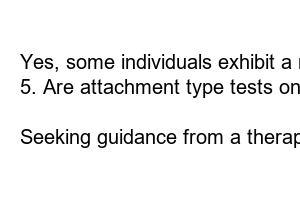애착유형 테스트
Are you curious about your attachment style? If so, taking an attachment type test can provide valuable insights into how you form and maintain relationships.
**What is an Attachment Type Test?**
An attachment type test is a questionnaire designed to assess your attachment style based on your beliefs, behaviors, and emotions in relationships. By answering a series of questions, you can uncover whether you have a secure, anxious, avoidant, or fearful attachment style.
**Why Take an Attachment Type Test?**
Understanding your attachment style can help you recognize patterns in your relationships and make more informed decisions about your love life. It can also provide valuable insights into how you respond to conflict, communicate with others, and navigate intimacy.
**How to Take an Attachment Type Test**
To take an attachment type test, simply search online for reputable assessments that measure attachment styles. Be honest in your responses, and remember that there are no right or wrong answers. The goal is to gain self-awareness and insight into your relational tendencies.
**Common Attachment Styles**
Secure attachment: People with a secure attachment style feel comfortable with intimacy and independence in relationships, and are able to trust and support their partners.
Anxious attachment: Those with an anxious attachment style tend to seek closeness and reassurance in relationships, but may worry about their partner’s love and commitment.
Avoidant attachment: Individuals with an avoidant attachment style value independence and may struggle with emotional intimacy and vulnerability in relationships.
Fearful attachment: Those with a fearful attachment style exhibit a mix of anxious and avoidant behaviors, and may have difficulty trusting others and forming secure bonds.
**Benefits of Knowing Your Attachment Style**
By knowing your attachment style, you can better understand your emotional needs, relationship patterns, and communication style. This self-awareness can lead to healthier and more fulfilling connections with others.
**The Importance of Therapy and Self-Reflection**
If you discover that you have an insecure attachment style, don’t despair. With the help of therapy and self-reflection, you can overcome past wounds and develop more secure attachment tendencies. Remember, it’s never too late to work on improving your relationships.
**Summary**
In conclusion, taking an attachment type test can offer valuable insights into your relational tendencies and help you navigate your love life with greater self-awareness. By understanding your attachment style, you can make more informed decisions about your relationships, communicate more effectively, and cultivate healthier connections with others. So why not take the test today and gain a deeper understanding of yourself and your relationships?
**FAQs**
1. How accurate are attachment type tests?
Attachment type tests are based on well-established psychological theories and research, making them a reliable tool for assessing attachment styles.
2. Can attachment styles change over time?
While attachment styles are often formed in childhood, they can evolve and change based on life experiences and personal growth.
3. Can therapy help improve insecure attachment styles?
Yes, therapy can be an effective way to work through past wounds, develop more secure attachment tendencies, and improve your relationships.
4. Is it possible to have a combination of attachment styles?
Yes, some individuals exhibit a mix of attachment styles, known as a fearful attachment style. Therapy can help address conflicting behaviors and emotions.
5. Are attachment type tests only for romantic relationships?
No, attachment styles can impact all types of relationships, including friendships, family dynamics, and professional interactions.
6. How can I interpret the results of an attachment type test?
Seeking guidance from a therapist or counselor can help you make sense of your results and identify ways to work on improving your attachment style.

